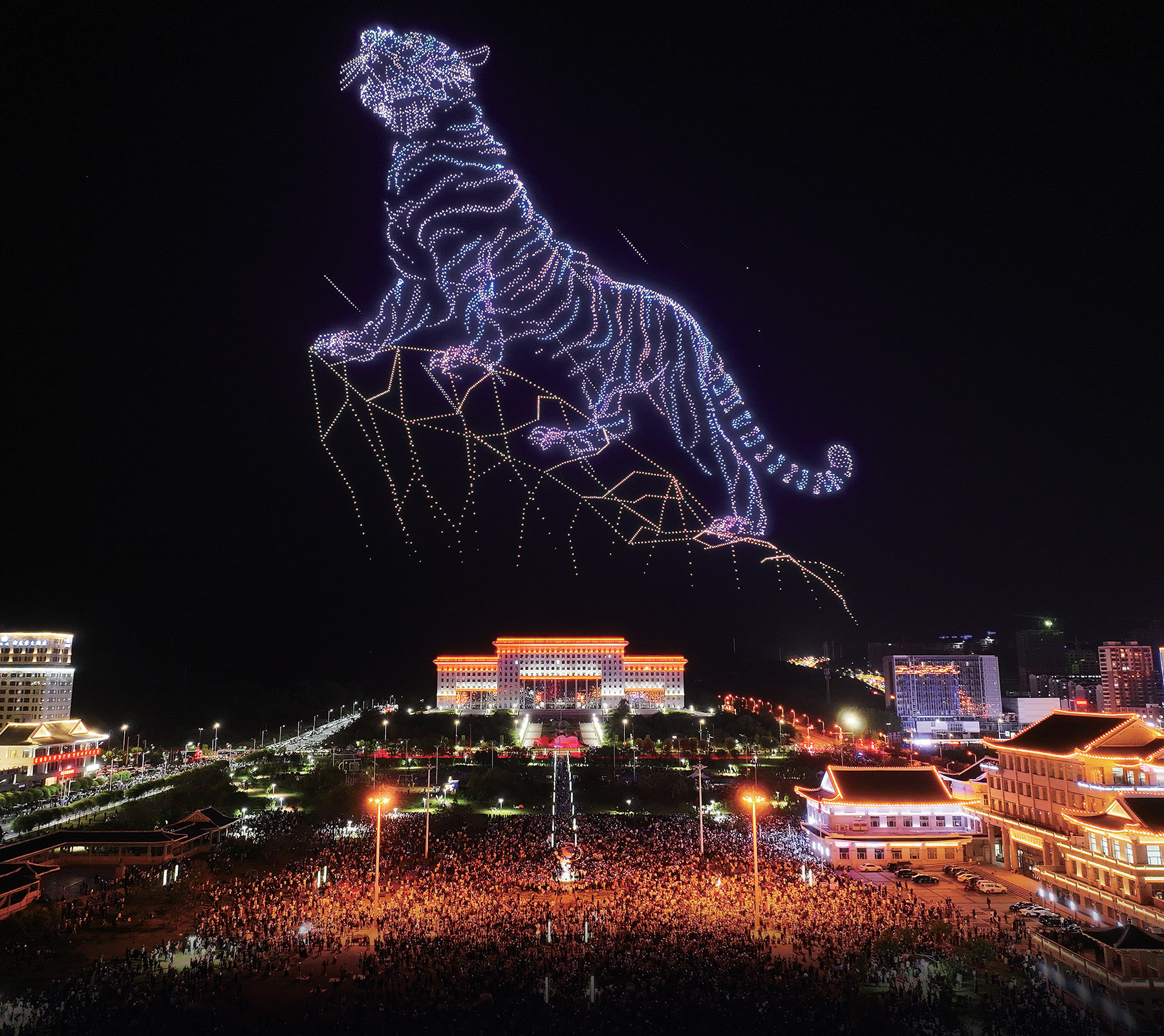A young, innovative team is revolutionizing drone light performances by combining technology with cultural storytelling.

On the evening of Jan 28, the Chongqing branch of the CCTV Spring Festival Gala showcased a breathtaking drone light performance. Three thousand drones took to the skies above the confluence of the Yangtze and Jialing rivers, forming various patterns that included Chongqing's iconic landmarks and the city's emblematic camellia flower.
This dazzling display was orchestrated by Damoda Intelligent Control Technology, a Shenzhen-based company specializing in drone shows.
It marked the company's sixth appearance at the gala. Despite challenges such as unpredictable weather, temperature fluctuations, signal interference, and varying wind speeds, the team successfully achieved a flawless 100 percent on-time takeoff and landing rate.
READ MORE: Shenzhen's record-breaking drone show kicks off National Day celebrations
The average age of this highly skilled team is only 27. Most members are graduates specializing in drone application technology, while some are drone enthusiasts recruited by the company. They channel their expertise and passion into this booming industry.
Jia Hengxiang, 27, from Lyuliang, Shanxi province, is the head of Damoda's flight engineering department. To complete a drone show, scriptwriters from the art engineering department first develop creative concepts and write programming scripts. Jia is responsible for leading the drone operators in executing the project.
In recent years, drone formation performances have become a major trend in night sky entertainment. Whether in major cities or small towns, at the Spring Festival Gala or the Olympics, domestically or internationally, these creative aerial displays have expanded people's imagination of light shows and highlighted the power of Chinese technology.
During this Spring Festival alone, Damoda presented 12 performances across various provinces and cities, including Sichuan, Hebei, and Tianjin.
Cyber fireworks
Jia noted that drones are less polluting and safer than traditional fireworks, and technological advancements have made larger-scale performances possible.
According to him, the company's first- and second-generation drones were limited because they had to be placed one by one. The third generation, however, could take off directly from a box, reducing the setup area and making them more suitable for diverse market scenarios.
"A venue that could only accommodate 200 first-generation drones can now handle 1,000 third-generation drones," he explained. "Moreover, our newly released fourth-generation drones don't even require battery removal for charging; they charge automatically."
The number of drones that can be coordinated simultaneously has also grown. "In 2019, flying 100 or 200 drones felt like a significant achievement. By 2021, flying 800 to 1,000 drones was considered a large-scale performance. But now, flying 1,000 to 2,000 drones is quite common," Jia said.
Last September, the team set two Guinness World Records in Shenzhen with 10,197 drones: the most multirotors/drones airborne simultaneously from a single computer (outdoors) and the largest aerial image formed by multirotors/drones.
This marks an industry breakthrough and represents an immense test of cluster control technology.
Jia explained that the main challenge lies in ensuring that the network bandwidth can support over 10,000 drones and that drones taking off from a sloped lawn can reach the same altitude in a short time, achieving automatic altitude calibration. In these aspects, Chinese drone performance teams, including Damoda, have reached a world-leading level.
However, Jia believes that the development of drone shows has now moved beyond simply pursuing quantity and has entered a phase of creative competition.
"Our current performances emphasize storylines and visual continuity. This requires drones to fly quickly and change formations swiftly," he explained. "We often need to delve deep into local cultures and incorporate them into the shows. For example, in our record-breaking performance in Shenzhen, we used 3,000 drones to create a screen in the sky, performing Wing Chun kung fu as if projecting a movie in the air."
One major challenge for drone shows is endurance limitations. Damoda's current drones can fly for about 15 minutes. "We are looking forward to breakthroughs in battery technology, which would allow for longer and more diverse performances," he said.
Global growth potential
Across the country, drone shows have become a booming attraction for cultural tourism. Most of Damoda's clients are local governments' cultural tourism departments and tourist site operators.
Drone shows are also part of the low-altitude economy. In low-altitude airspace — typically referring to vertical heights below 3,000 meters — manned or unmanned aircraft are widely used for performances, aerial inspections, logistics delivery, agricultural protection, emergency rescue, and other applications.
In 2024, the low-altitude economy was included in China's Government Work Report for the first time, recognized as a new growth engine. The Civil Aviation Administration of China predicts that by 2025, the market size of China's low-altitude economy will reach 1.5 trillion yuan ($205.26 billion), and by 2035, it could grow to 3.5 trillion yuan.
ALSO READ: Drone operator spells out unique perspective
Take Damoda as an example: the company not only delivers drone performances but also manufactures the equipment. Its third- and fourth-generation drones are fully produced domestically, using domestic chips and the Beidou Navigation Satellite System.
In 2024, Damoda expanded into the South American and European markets, selling equipment to over 50 countries and regions. The company's overseas business volume increased by more than 30 percent last year.
"Drone formation performances have become common even in China's third- and fourth-tier cities, but the potential in overseas markets is still significant," Jia said.


